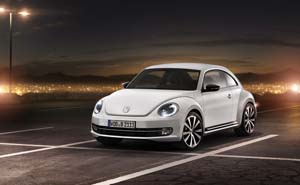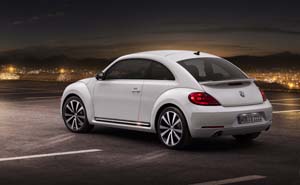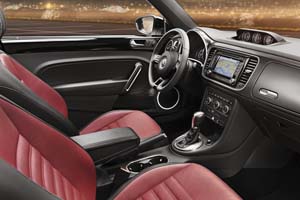Seventy-five years ago, there was no Beetle. There was only the “people’s car,” or Volks Wagen. And even that little car might have vanished into the wreckage of World War II were it not for an enterprising British officer who found one of the few models to survive amidst the rubble at a plant in Wolfsburg, Germany.
Eventually, what the little insect-like coupe would go on to become the most popular car in automotive history, ultimately selling nearly 5 million copies before it was replaced by the “New” Beetle, in 1998. The update has proven controversial and far less successful. No wonder Klaus Bischoff the Volkswagen brand design chief was nervous when given the challenge of developing what was to become only the second complete redesign of the Beetle in three quarters of a century.
There was plenty of debate inside the German automaker as to whether the Beetle should even be updated or simply abandoned, Bischoff tells TheDetroitBureau.com. His position was simple: “I didn’t want to lose this beloved icon for the brand.”
But as he and his team set out to come up with a suitable replacement, Bischoff says it was clear they had to both look forward and backwards at the same time.
“It was clear for us designers that we didn’t want to follow the path of the New Beetle. That game was over,” he recalls. “After six months (of preliminary studies), it was clear we needed to follow the key dimensions of the original.”
The ’98 New Beetle was effectively a large semi-circle, the drive placed almost in the middle. That resulted in a lot of open space up front, but limited headroom for the rear passengers and very little cargo space.
“You had half of the interior ahead of you which you couldn’t use,” laments Bischoff. The overall design was closer to an MPV (minivan) than a sports car.
It was also a rather feminine design, Bischoff concedes, something an analysis of TrueCar data backs up. Almost two-thirds of current U.S. Beetle sales are to women.
(Click Here for TheDetroitBureau.com’s report on the official 2012 Beetle launch event.)
For the 2012 model, the goal was to recapture some of the signature design elements, such as the first Beetle’s upright grille, large round headlights, extended sloping hood – and its more driver-oriented interior.
That meant a cockpit like design that has a lot in common with the Porsche 911, which also traces its roots back to the legendary Ferdinand Porsche, who crafted the original Beetle.
The new Beetle is a half inch lower, with a slightly less rounded roof. It is several inches wider and about six inches longer. By pulling the engine forward, the two rows of seats shift forward. That not only yields a more driver-centric layout, but also delivers more rear headroom and a larger cargo compartment.
“This is a cockpit,” Bischoff says proudly. “The old one was a living room.”
Getting the design right is critical, echoes Jonathan Browning, who was named CEO of Volkswagen Group of America, late last year. The little coupe isn’t going to be the big volume seller in the line-up, he acknowledges. That’s for products like the Jetta and Golf. But the Beetle “is part of the heartbeat of the organization.”
That’s especially so in the U.S., where demand for the Beetle has traditionally been strongest. VW has struggled for decades to build its presence in the States, and still lags the record volumes set when the original car was still at its peak, four decades ago. But the maker is hoping to double sales – to about 800,000 – by 2016, and the 2012 Volkswagen Beetle could provide a much-needed halo, admits Browning.
At the same time, “The American customer influences all customers worldwide,” stresses Bischoff. They “set the trends here that set the trend worldwide.”
Or so VW hopes. The 1998 Beetle remake never really clicked outside the U.S., but Volkswagen is betting the new, more macho design will yield positive results from Berlin to Beijing. Especially in Beijing. VW is locked in a heated battle with General Motors for dominance in the fast-growing Chinese market and the Beetle could be the distinctive icon it needs to gain the lead.
While a fresh design was critical for the 2012 Beetle, VW’s Browning acknowledges that the maker has to deal with other issues that hurt the ’98 New Beetle. Like quality and customer service, both of which he insists, “We’re very focused on” as the new model approaches production launch later this year.
At a preview of the 2012 Volkswagen Beetle, the word, “retro” was readily bandied about. That was a popular design trend when the 1998 model came out but has since become something anathema to many automotive designers.
Not Bischoff. “If you call it retro, I’m not bothered,” he insists. “I’d rather copy myself than somebody else. You have to understand what brand you are working for.
“It’s like having a vault,” he contends. “You go in and your job is to get the gold out of the vault.”




